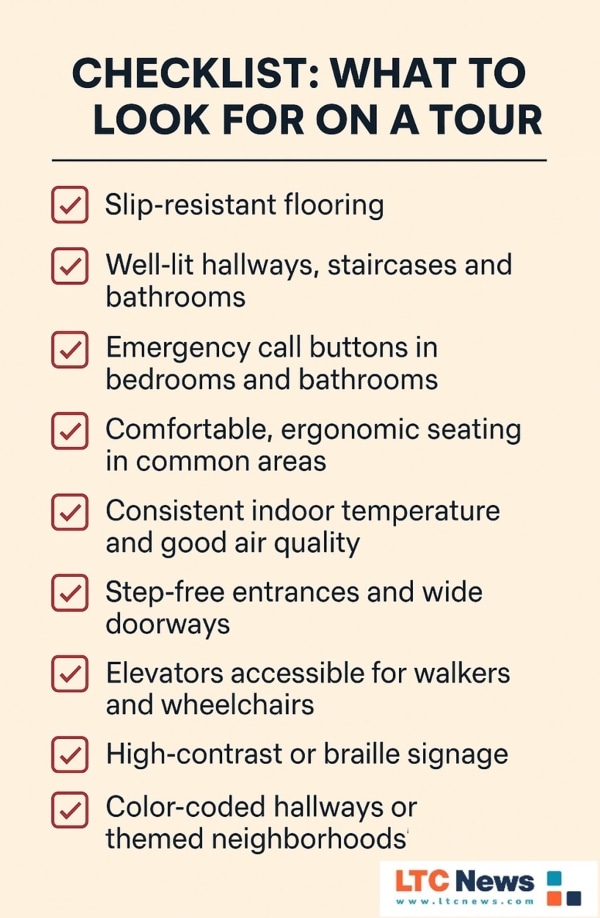Beyond Four Walls: Thoughtful Design Transforms Senior Care Facilities into Quality Care Environment

You’ve probably walked into a senior care facility before—maybe to visit a parent, a grandparent, or a friend—and felt the weight of the environment the moment you stepped inside. The colors, the smells, the lighting, even the way furniture is arranged, can instantly make you feel either at ease or uneasy.
Now imagine living there. For older adults, this isn’t just a place to stay; it’s their home, their community, and their daily world.
If you’re thinking about your own future or helping someone you love make the transition, you know how overwhelming the process can be. You’re worried about safety—Will they fall? Will they get lost? You’re worried about loneliness—Will they make friends? Will they feel at home? And you’re worried about dignity—Will they still feel like themselves in a shared space?
There are many worries, and these can be compounded if a family crisis arises due to a lack of planning.
Clearly, most people want to remain at home; however, sometimes a long-term care facility is a better option. That’s why the way a senior care facility that is well designed matters more than you might think.
Beyond the price tag, amenities, and location, the actual design of the building—the lighting, the hallways, the rooms, the outdoor spaces—shapes every moment of daily life for its residents. When the environment feels safe, welcoming, and supportive, older adults can live with more independence, confidence, and joy. The bottom line is quality care in a safe environment.
Safety and Functionality Come First
Safety is the foundation of every good senior care facility. As we age, changes in balance, vision, and reaction time make us more vulnerable to accidents—especially falls. According to the CDC, one in four Americans aged 65+ falls each year, and falls remain the leading cause of fatal and nonfatal injuries among older adults. Thoughtful design can dramatically lower those risks and help residents move confidently through their daily routines.
This is where small, consistent details matter. Slip-resistant flooring helps prevent slips in high-traffic areas. Wide hallways make it easier for two people, or a person and a wheelchair, to pass without bumping into one another. Handrails and grab bars along corridors and in bathrooms offer a stable point of contact when residents need support. Even lighting plays a role, since harsh glare or dark shadows can make it harder to see and react to obstacles.
Key elements to look for include:
- Slip-resistant flooring and wide, uncluttered hallways reduce tripping hazards.
- Sturdy handrails and grab bars provide confidence and support.
- Soft, evenly distributed lighting eliminates harsh glare and helps older eyes see obstacles clearly.
There is growing evidence that the design of the built environment, by itself and in combination with organizational policies and procedures, has a direct and measurable impact on the physical and psycho-social functioning of residents with dementia, which may translate into higher quality of life. — Margaret P. Calkins, Ph.D., M. Arch, Evidence-based Long Term Care Design
Comfort and Emotional Well-Being
Safety may protect your body, but comfort nourishes your mind. A well-designed senior care facility understands that older adults spend most of their time indoors. The right mix of furnishings, temperature control, and social spaces creates an environment where residents feel valued, not institutionalized.
Comfort starts with furniture designed for older bodies—chairs with supportive backs, higher seat heights, and armrests that make standing easier. Beyond physical comfort, common areas should encourage conversation and community. Soft lighting, warm color schemes, and quiet zones help residents relax, while small gathering spaces spark friendships.
Temperature control also matters. Older adults are often more sensitive to fluctuations in temperature, and an inconsistent indoor climate can lead to discomfort or even health complications. Features like draft-free windows, well-insulated walls, and the ability to adjust personal room temperatures can make a significant difference in how “at home” a resident feels.
Modern facilities often include:
- Ergonomic furniture with higher seat heights and armrests to ease standing.
- Quiet lounges and cozy gathering areas that encourage socialization.
- Individual climate control in resident rooms for temperature-sensitive older adults.
Accessibility for All Abilities
Accessibility is about dignity and independence. Whether you use a walker, a wheelchair, or just prefer extra space to maneuver, a facility designed with accessibility in mind empowers you to move freely without relying on others. This goes beyond ADA compliance—it’s about creating an environment where everyone can thrive.
Step-free entrances and wide doorways eliminate barriers for mobility devices. Elevators ensure residents can access every floor without needing staff assistance. Adjustable countertops, roll-in showers, and accessible bathrooms enable individuals to perform daily tasks independently, which boosts confidence and preserves their independence.
Another key element of accessibility is wayfinding—how easily someone can orient themselves and navigate the building. Clear signage with large print, high contrast, and even braille is invaluable. Seniors with visual impairments greatly benefit from room number signs with braille in assisted living spaces.
Facilities that take accessibility seriously often feature:
- Step-free entries, elevators, and wide doorways for walkers and wheelchairs.
- Adjustable countertops and accessible bathrooms to maintain independence in daily tasks.
- Effective wayfinding with large-print, high-contrast, and braille signage for those with low vision or cognitive changes.
Design and Dementia Care
Design can also support cognitive health. For people living with Alzheimer’s or another form of dementia, the environment can either soothe or confuse. Facilities that understand this use color, layout, and outdoor spaces to reduce agitation, support orientation, and promote safe exploration.
Color-coded hallways or themed “neighborhoods” make it easier for residents to recognize their areas. Secure outdoor courtyards with circular walking paths allow people to enjoy fresh air without the risk of wandering off. Simple, intuitive room layouts with minimal clutter reduce sensory overload and confusion.
Look for features such as:
- Color-coded hallways or themed “neighborhoods” for orientation.
- Secure outdoor courtyards with circular walking paths.
- Simple, intuitive room layouts with minimal clutter.
According to the Alzheimer’s Association, such environmental cues can lower stress levels and help maintain autonomy for people with memory loss.
Finding Quality Long-Term Care Services
Design matters, but so does quality of care. Even the most beautiful facility can fall short if staffing, services, or safety measures are lacking. Before committing, you need to evaluate not just the building but also the people who will be caring for you or your loved one.
The LTC News Caregiver Directory is one of the largest, most up-to-date databases of caregivers, assisted living facilities, and other long-term care providers in the U.S. It’s a powerful tool for narrowing your search and comparing options in your area.
Start by entering your ZIP code or city. This brings up a list of local providers, complete with contact details, services offered, and in many cases, reviews or ratings. From there, you can filter by type of care—such as in-home care, assisted living, memory care, or nursing homes—so you’re only looking at providers that match your needs.
Here’s how to make the most of it:
- Define your priorities: Decide which services and design features matter most—memory care, private rooms, or accessibility upgrades.
- Use filters: Narrow results by type of care, location, and specialty services.
- Compare providers: Look at the details of each listing, including staff credentials, inspection reports, and consumer reviews.
- Schedule visits: Once you’ve narrowed down your list, visit in person to assess design, staffing, and atmosphere.
Long-term care service providers are updating or adding to their existing listings daily. Claim your free listing on the LTC News Caregiver Directory and/or upgrade the listing to enhance visibility and highlight your staff and services through the LTC News Directory Business Portal.
For families, using the Caregiver Directory helps you move from overwhelming possibilities to a focused list of options that fit your budget, location, and quality expectations.
Financial Side: Planning Ahead
Great design often comes at a higher price. Private rooms, advanced safety systems, and specialized dementia units can significantly increase monthly costs. These costs can be higher if a loved one does not have Long-Term Care Insurance. If they do, be sure the admissions director is aware of the policy.
- Learn more: How Does Long-Term Care Insurance Work?
Before deciding on any caregiver or extended care facility, take time to research the true cost of living in a well-designed senior care community.
The LTC News Cost of Care Calculator is a trusted resource that lets you see the median average costs for in-home caregivers, adult day care centers, assisted living, memory care, or nursing homes in your area. This helps you plan—and compare—before you commit.
Important note: The extended care cost calculator can be helpful when you design your Long-Term Care Insurance policy. Search by zip code and work with a qualified LTC Insurance specialist to provide you with accurate quotes from all the top insurance companies that offer long-term care solutions.
An LTC policy can also help you access higher-quality facilities and more personalized accommodations, as facilities often put you ahead of others, knowing they will get paid right away.
Helpful hint: LTC News partners with Amada Senior Care to provide free claim support with no cost or obligation. Their trained experts can walk you through the entire process and help you or a loved one access their benefits quickly and correctly — File a Long-Term Care Insurance Claim.
Checklist: What to Look for on a Tour
Visiting a facility in person is the best way to gauge whether its design matches its marketing. Bring a notebook or use your phone to jot down observations, and don’t be afraid to ask questions about design choices. Think about how you’d feel living there every day.
Here are some points to guide your visit:
- Safety: Slip-resistant flooring, handrails, and emergency call systems.
- Lighting: Consistent, glare-free illumination, especially in hallways and bathrooms.
- Comfort: Temperature control, noise levels, inviting lounges.
- Accessibility: Step-free access, elevators, wide hallways, and braille signage.
- Wayfinding: Clear room numbers, color-coded areas, memory-support cues.
- Outdoor Access: Secure courtyards, gardens, and walkways.
- Staff Interaction: Observe how staff talk to residents and handle mobility assistance.

Bringing it Together
Design is more than décor—it’s a tool for dignity. Every handrail, hallway, and color choice can make daily life safer, calmer, and more independent for older adults. When you’re evaluating senior care facilities, look beyond the brochure photos. Walk the halls, test the lighting, sit in the chairs, and ask tough questions about accessibility.
You’re not just choosing a building—you’re choosing a home that will shape your health and happiness for years to come.


